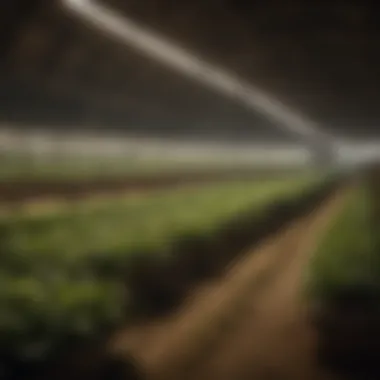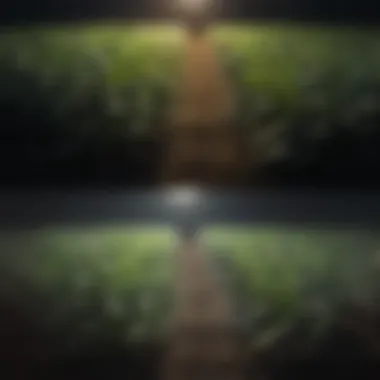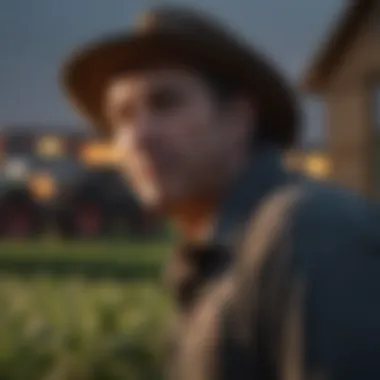Revolutionizing Agriculture with Phantom Double Ended Lighting


Intro
The advancement of lighting technologies significantly impacts agriculture, particularly in controlled environments like greenhouses and indoor farms. Among these innovations, the Phantom Double Ended Lighting System emerges as a leading choice for enhancing crop growth. By delivering optimal light intensity and spectrum, this system allows farmers to cultivate crops more efficiently and effectively. The following exploration will delve into the specifics of this technology, discussing its design, current applications, and the benefits it offers the agricultural community.
Topic Overview
Definition of Key Terms
The term photon refers to the basic unit of light, essential for photosynthesis in plants. The double-ended lighting system typically involves lamps with two ends, enhancing light output and efficiency. This system usually pairs with advanced reflectors to amplify light distribution in growing areas.
Relevance in Agriculture, Horticulture, and Agronomy
In agriculture, particularly in horticulture, proper lighting is crucial for maximizing yields. Horticulturists utilize specific light spectrum wavelengths to stimulate growth stages. The Phantom Double Ended Lighting System addresses these needs, providing a versatile solution for varied crop types. Understanding its features and applications helps farmers make informed decisions in choosing lighting systems.
Current Trends and Innovations
Recent Advancements in the Field
Recent developments in lighting technology focus on optimizing energy use while maintaining high light quality. The Phantom Double Ended Lighting System integrates improved ballast technology, which ensures better energy efficiency compared to traditional systems. Furthermore, these systems often use ceramic metal halide lamps, known for their stability and longevity.
Emerging Technologies and Practices
The shift towards sustainable farming practices is shaping the landscape of agricultural lighting. New systems emphasize reduced energy consumption and increased light penetration. Additionally, many designs now incorporate smart technologies to monitor and adjust lighting conditions based on plant needs.
Practical Applications
Step-by-Step Guides or How-Tos
When implementing the Phantom Double Ended Lighting System, consider the following steps:
- Assess Your Space: Measure your growing area to determine the number of lamps needed.
- Choose the Right Spectrum: Select lamps with spectra that match your crops’ growth stages.
- Install Properly: Ensure correct mounting height and distance from plants to avoid light burn.
- Monitor Performance: Regularly check the system's output and plant response to optimize settings.
Tips and Best Practices for Implementation
- Employ reflective materials to direct light to plants efficiently.
- Schedule lighting to mimic natural conditions, promoting healthy plant cycles.
- Regularly clean lamps to maintain optimal light intensity.
"Effective lighting can significantly reduce crop cycle times and improve overall yield."
Embracing the Phantom Double Ended Lighting System aligns with modern agricultural practices, emphasizing productivity and sustainability. The exploration of this system sheds light on not only its advantages but also potential challenges. Future research could lead to enhancements, making this technology an even more valuable resource for farmers.
Preface to Lighting Systems in Agriculture
Lighting systems play an essential role in modern agriculture. They directly influence plant growth, development, and productivity. As agricultural practices evolve, the need for effective lighting solutions becomes more pronounced. This article delves into a specific innovation in this area, the Phantom Double Ended Lighting System, and its potential in optimizing agricultural production.
The Role of Lighting in Plant Growth
Light is a critical factor for photosynthesis, the process by which plants convert light energy into chemical energy. This energy supports growth and yields in crops. Different plants require varying light intensities and spectra to thrive.
For instance, certain plants prefer full-spectrum light, while others might benefit from specific wavelengths. The timing of light exposure also matters; it can significantly affect flowering and fruiting. Understanding these dynamics allows farmers to tailor their lighting strategies according to crop needs. This not only enhances growth but can also lead to higher quality produce.
Traditional Lighting Methods


Historically, agriculture has relied on several lighting methods. Among these are incandescent bulbs, fluorescent lights, and high-intensity discharge (HID) lamps. Each method has its pros and cons.
- Incandescent bulbs offer low initial costs but are highly inefficient and have a short lifespan.
- Fluorescent lights are more efficient than incandescent options and provide better light quality. However, they often lack the intensity needed for larger crop areas.
- HID lamps, meanwhile, are potent and widely used in large-scale operations. They emit a lot of heat and require careful management to avoid overheating crops.
While all these methods have contributed to agricultural advancement, they also present limitations. For instance, energy consumption and heat production can create additional costs and management challenges. As such, exploring innovative solutions like the Phantom Double Ended Lighting System seems timely and necessary.
Overview of the Phantom Double Ended Lighting System
The Phantom Double Ended Lighting System is crucial in modern agriculture, especially in regions where sunlight is limited or during off-seasons. It enables farmers to achieve optimal plant growth by providing a consistent light source. This system represents a paradigm shift from traditional lighting, promising higher yields and better quality crops.
Design Features
The design of the Phantom Double Ended Lighting System incorporates several innovative elements that enhance its functionality. One notable feature is its double-ended bulb structure, which offers a wider surface area. This design ensures that light is dispersed evenly across the growing area.
The reflectors used in this system are also superior. Typically, they are crafted from high-quality materials that maximize light reflection. This reflection minimizes light loss and maximizes the amount of usable light for plants.
The installation of this lighting system is relatively straightforward. It is designed to fit into existing setups, allowing for easy upgrades from older systems. Additionally, it can be suspended from different heights, giving farmers the flexibility to control the intensity of light according to the specific needs of their crops.
Technical Specifications
Understanding the technical specifications of the Phantom Double Ended Lighting System is pivotal for evaluating its effectiveness. The average wattage of these systems ranges between 600 and 1000 watts, providing sufficient power for various agricultural applications.
The light spectrum produced by this system closely resembles natural sunlight, which is beneficial for photosynthesis. It primarily emits higher amounts of blue and red wavelengths, essential for plant growth.
Another important spec is its lifespan. These bulbs can last up to 20,000 hours depending on usage, which significantly outperforms many traditional lighting options. This efficiency translates to lower maintenance costs and less frequent replacements.
Farmers may notice some initial costs when transitioning to this lighting system. However, the energy savings achieved over time, combined with enhanced crop yields, typically justify this investment. Implementing the Phantom Double Ended Lighting System can lead to dramatic improvements in output and overall farm profitability.
A solid understanding of these design features and technical specifications can help farmers and horticulturists make informed decisions regarding their lighting systems.
"The effective use of the Phantom Double Ended Lighting System could redefine agricultural practices, leading toward more sustainable and productive farming methods."
Benefits of the Phantom Double Ended Lighting System
The Phantom Double Ended Lighting System provides several advantages that make it an appealing choice for modern agricultural practices. With the increasing need to optimize crop production and ensure sustainable farming methods, this system stands out as a significant improvement over traditional lighting technologies. The following sections detail the specific benefits of this innovative lighting solution.
Energy Efficiency
One of the primary benefits of the Phantom Double Ended Lighting System is its energy efficiency. This system uses less electricity compared to conventional lighting systems like high-pressure sodium lamps. The design of the double-ended bulbs promotes better light output while consuming lower amounts of power.
Farmers can expect to see a reduction in their utility bills as a direct result. This savings is especially important in large agricultural operations where lighting costs can escalate. Additionally, the longer lifespan of these bulbs means that replacements are less frequent, further adding to the overall cost savings.
Enhanced Light Distribution
The design of the Phantom Double Ended Lighting System allows for enhanced light distribution. The system is engineered to emit light in all directions, resulting in improved uniformity of illumination across the growing area. This is particularly important for plants that require consistent light levels.
With better light distribution, farmers can ensure that all parts of their crops receive adequate light exposure. This can lead to stronger plant growth and reduce the likelihood of shadowing, which can occur with more directional lighting systems. Consequently, this feature helps farmers achieve better results in their crop production.
Improved Crop Yields
Investment in the Phantom Double Ended Lighting System often leads to improved crop yields. The combination of energy efficiency and enhanced light distribution means that plants can photosynthesize effectively and grow at a faster rate. When plants receive the right quality and quantity of light, they naturally produce more biomass and higher yields.
Moreover, studies show that some growers report yield increases of up to 20% when switching from traditional lighting methods to this advanced system. The consistency in light quality also contributes to more uniform harvesting, which is crucial for maintaining high market standards.


"Effective lighting is not just about brightness; it's about ensuring that every plant benefits equally from available light."
Applications in Modern Agriculture
The Phantom Double Ended Lighting System has transformed various sectors of modern agriculture. Its effectiveness in promoting plant growth makes it relevant for different farming methods. As the demand for food increases globally, adopting innovative lighting solutions becomes essential. The applications of this lighting system can be seen primarily in three key areas: indoor farming, greenhouses, and field production. Each of these areas utilizes the technology differently, yet all reap significant benefits.
Indoor Farming
Indoor farming operates in controlled environments, allowing growers to maximize yields throughout the year. The Phantom Double Ended Lighting System excels in these settings due to its superior light distribution. By providing plants with an optimal light spectrum, this system enhances photosynthesis, leading to faster growth.
Moreover, indoor facilities can precisely control growing conditions, making them less vulnerable to environmental changes. The compact design of the lighting systems also ensures that they fit well into limited spaces, unlike bulkier lighting options. Important to note is the energy efficiency of the Phantom system, which can translate to lower operational costs over time.
Greenhouses
Greenhouses benefit from the Phantom Double Ended Lighting System by enhancing natural light with artificial illumination. This hybrid approach ensures that plants receive the necessary light even during cloudy days or the winter season when sunlight is minimal.
Growers can strategically place these lights to fill in light gaps, improving overall plant health and productivity. Furthermore, the energy efficiency factor is crucial in these setups as it helps reduce the carbon footprint of greenhouse operations. The system’s design allows for easy installation and adjustment according to the specific needs of different crops.
"The integration of advanced lighting systems like the Phantom can crucially impact crop health and profitability in greenhouse farming."
Field Production
Field production presents unique challenges that can benefit from employing the Phantom Double Ended Lighting System. While it may seem less applicable to open fields, strategic use of lighting can aid in specific circumstances. For instance, during early spring or late fall, additional lighting can help crops that are sensitive to photoperiodic changes to flourish.
By applying this system selectively, farmers can optimize conditions for high-value crops to ensure a better outcome before harvest. The initial installation costs may be a consideration, but the potential increase in yield can justify the investment. Moreover, the long-term benefits regarding sustainability and efficiency should not be overlooked.
Comparative Analysis with Traditional Lighting
The comparative analysis between the Phantom Double Ended Lighting System and traditional lighting methods is crucial for understanding the former's advantages within contemporary agricultural practices. As agriculture continues to evolve, the techniques and technologies used in crop cultivation also must adapt to meet the growing demands for efficiency and productivity. This analysis highlights key aspects, including cost considerations and the inherent differences in light quality and spectrum, that farmers and producers should evaluate when selecting a lighting system.
Cost Consideration
The initial investment required for the Phantom Double Ended Lighting System typically surpasses that of traditional light sources such as fluorescent or high-pressure sodium lights. However, the long-term savings can justify the upfront expense. Operating costs, including energy consumption and maintenance, are significantly lower with the Phantom system. It boasts higher energy efficiency, translating into lower utility bills and an extended lifespan, which reduces replacement costs.
"Investing in superior lighting technology may appear daunting, but the potential for cost efficiency through less frequent replacements and lower energy use should not be overlooked."
Farmers must consider not just the initial price, but also the total cost of ownership over time. This includes evaluating warranties, expected lifespan, and energy efficiency ratings. The increased effectiveness of the Phantom Double Ended system can lead to
- Improved growth rates
- Higher yield quality,
- In some cases, reduced labor costs due to automation compatibility.
Light Quality and Spectrum
Light quality plays a significant role in plant growth and development. The Phantom Double Ended Lighting System produces a spectrum that resembles natural sunlight, which is essential for photosynthesis. Unlike traditional lighting methods that may emit a narrower spectrum, the Phantom system distributes light more evenly and covers a broader range of wavelengths. This quality affects:
- Photosynthetic efficiency: Plants thrive when provided with the correct wavelengths, enhancing growth and biomass production.
- Flowering and fruiting times: The proper light spectrum can accelerate these processes, leading to quicker turnaround for harvests.
- Plant health: Improved light quality reduces stress in plants, making them more resilient to pests and diseases.
The difference in light spectrum cannot be understated. Research has shown that certain wavelengths can influence plant traits significantly, such as height and leaf size, ultimately affecting marketability. In summary, while traditional systems may be less expensive initially, the Phantom Double Ended Lighting System’s superior light quality presents compelling advantages that can enhance crop productivity and profitability.
Challenges in Implementing the Phantom System
The Phantom Double Ended Lighting System, while offering numerous advantages to modern agriculture, does not come without its challenges. Understanding these obstacles is essential for farmers and agricultural enterprises considering its adoption. Addressing the following topics can illuminate both the complexities and considerations necessary for successful implementation: initial investment and technical expertise.


Initial Investment
The introduction of the Phantom Double Ended Lighting System often requires a substantial initial investment. This capital outlay can encompass several aspects including the cost of the equipment, installation services, and potential modifications to existing infrastructure.
- Equipment Costs: The Phantom system typically consists of specialized fixtures and bulbs that can be more expensive than traditional lighting solutions. Budget constraints can make this upfront expense daunting for many farmers.
- Installation Expenses: Implementing the system may also involve hiring skilled labor for installation to ensure that the equipment is set up properly. This can add to the financial burden.
- Infrastructure Adjustments: Some farms might need to adapt their current facilities to accommodate the new lighting system, which could include structural changes or electrical upgrades.
Given these factors, farmers need to weigh the potential long-term savings and increased yields against the initial expenditure. An analysis of return on investment can guide decisions in this regard.
Technical Expertise
Beyond the financial implications, another significant challenge associated with the Phantom Double Ended Lighting System is the level of technical expertise required for effective implementation and maintenance.
- Understanding Operation: Farmers and their staff may need additional training to operate the system efficiently. Acquiring knowledge about optimizing light schedules and managing energy use is crucial for leveraging the system's full potential.
- Troubleshooting and Maintenance: Like any advanced technology, the Phantom system may encounter technical issues that require skilled personnel for troubleshooting and repair. Access to knowledgeable technicians becomes essential, especially in rural areas.
- Integration with Existing Systems: If farmers intend to combine the Phantom system with other technologies, such as climate control or automated irrigation systems, expertise in multiple disciplines may be needed to ensure seamless integration.
As horticulturists and farmers contemplate the introduction of the Phantom Double Ended Lighting System, it is crucial to recognize these challenges. Adequate planning, resource allocation, and possibly upskilling staff are necessary to navigate the landscape efficiently.
"The adoption of advanced lighting systems in agriculture must be approached with careful consideration of both investment and expertise needed for successful implementation."
Ultimately, confronting these challenges proactively will enhance the likelihood of successful integration of lighting systems that can improve crop yields and operational efficiency.
Future Directions for Research and Development
Research and development in agricultural lighting systems is crucial for adapting to the evolving needs of farmers and the challenges posed by climate change and food sustainability. The Phantom Double Ended Lighting System stands at the forefront of these advancements, combining efficiency with effectiveness. Future research may focus on optimizing its use in various agricultural settings, ensuring that it meets the demands of different crops and environments.
Innovations in Plant Lighting
Innovations in plant lighting are rapidly progressing. Notably, advancements in LED technology promise to deliver higher efficiency and improved light spectrum customization. Research studies are investigating how new light wavelengths can stimulate specific plant responses, enhancing photosynthesis and overall plant health. Systems that can adjust light intensity and color based on real-time monitoring of plant needs will likely emerge.
Moreover, hybrid lighting systems combining both traditional and LED technologies may provide a more balanced light environment for crops, ensuring optimal growth conditions.
- Adaptive Light Systems: These systems will respond to environmental changes, fine-tuning themselves to maximize effectiveness.
- Automated Controls: Sensors might be integrated to measure plant health, adjusting light settings automatically to cater to crop needs.
The potential for innovative systems to deliver tailored lighting solutions could revolutionize horticultural practices as we know them.
Integration with Smart Farming Technologies
The integration of the Phantom Double Ended Lighting System with smart farming technologies signifies a pivotal step in modern agriculture. Smart farming leverages technologies such as IoT (Internet of Things) devices, data analytics, and machine learning to optimize farming operations through precision agriculture.
For example, intelligent sensors can be employed to gather data on soil moisture, nutrient levels, and light absorption. This data can help enhance the performance of lighting systems by adjusting their output in relation to the current needs of the plants.
Such integration offers multiple benefits:
- Improved Resource Allocation: Efficient light usage leads to better resource management, saving energy and reducing costs.
- Optimized Growth Conditions: By fine-tuning lighting based on precise data, farmers can create ideal growth environments for different plant species.
In summary, ongoing research and the potential future developments in lighting systems, particularly the Phantom Double Ended Lighting System, will likely lead to substantial benefits in agricultural productivity and sustainability. This will position farmers and horticulturists to face emerging challenges more effectively.
Finale
The conclusion serves as a vital component of this exploration into the Phantom Double Ended Lighting System in agriculture. It encapsulates the significance of innovative lighting solutions in enhancing agricultural practices, especially within the context of modernity and sustainability. As we have discussed, this advanced lighting technology offers several distinct advantages over traditional methods. These include improved energy efficiency, superior light distribution, and ultimately, enhanced crop yields.
While reflecting on the potential implications of adopting such systems, it's crucial to note several considerations. Farmers must assess the initial investment required against the long-term benefits of increased productivity and reduced energy costs. Moreover, understanding the specific needs of various crops can help them tailor the use of the Phantom system effectively.
The Future of Agricultural Lighting
The future of agricultural lighting is closely tied to advancements in technology and an increasing understanding of plant needs. Innovations like the Phantom Double Ended Lighting System are at the forefront of these changes. As more farmers recognize the benefits of precise light spectra and energy-efficient designs, we can expect a shift in lighting choices influenced by data-driven methods.
Integration with smart farming technologies is an area poised for growth. Automation and remote monitoring can allow for more efficient use of lighting systems, adapting as necessary throughout plant growth cycles. Here are some key trends to watch:
- Increased adoption of LED technology which offers low power consumption and long lifespans.
- Smart lighting controls allowing farmers to adjust light based on real-time feedback.
- Research into plant-specific light needs guiding tailored lighting solutions.



